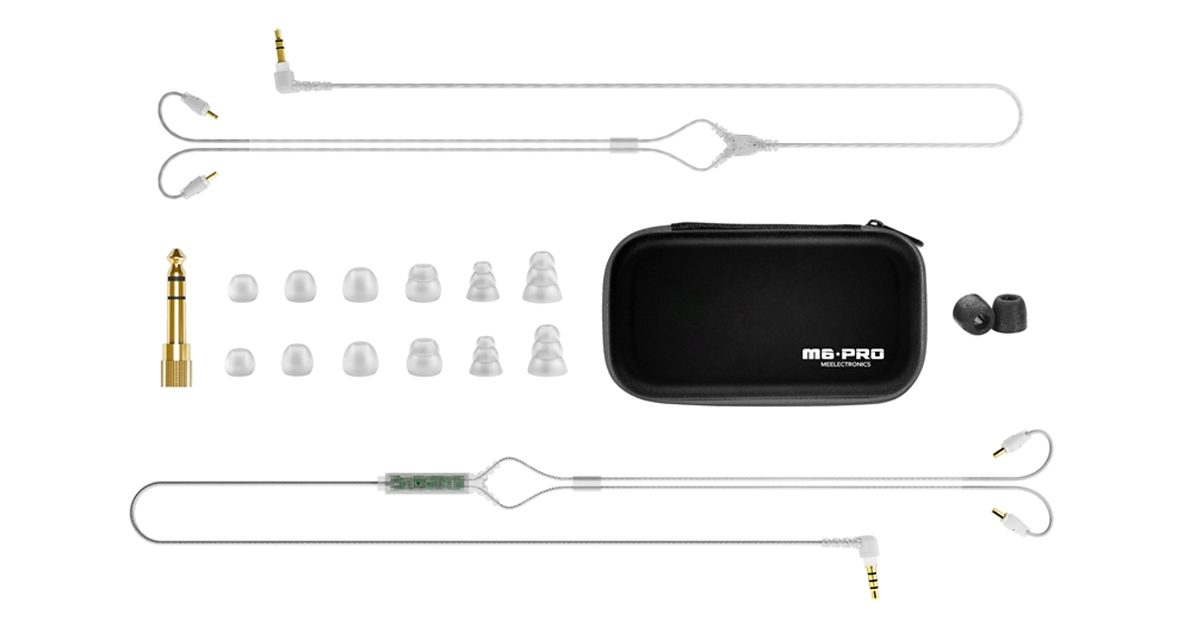The Lowdown
Price, value, and comfort come together to make the M6 Pro a compelling entry-level package that’s hard to beat. It’s perfect for DJs who want to try getting into in-ear monitor mixing, just don’t expect them to sound amazingly stellar.
Video Review
First Impressions / Setting up
The M6 Pros come in a normal box, but you’ll be surprised at the amount of goodies inside. Apart from the monitors themselves, you’re getting two sets of sweat-resistant cables (one standard, one with a microphone and volume remote for using with mobile devices), a pack of different-sized silicone tips, a pair of Comply foam tips (the best and what I always use with IEMs), a 1/4” adapter, and a zippered hardshell case. That’s a ton of value for something that costs under US$50 – you won’t need to fork out cash for extra accessories.
In Use

I like how the M6 Pros sound: they’re a bit brighter than what I’m used to, but that’s not a deal-breaker for me, and while the lows aren’t exceptionally pronounced, there’s certainly enough of it, though bass-heads may find them a bit lacking when listening to genres like dub and trap. The mids are the strongest suit of this IEM pair, with vocals and synth elements coming out clear. If you DJ a lot of EDM and Top 40, you’ll enjoy listening and DJing with these.
I never enjoyed silicon ear tips because I just feel like they’re uncomfortable, and I wasn’t surprised to find that I didn’t like the ones that came with the M6. IEMs require a proper fit in order to sound their best, and a proper fit is exactly what I got with the Comply tips: The sound isolation is a lot better, plus IEMs sound tinny when they don’t fit flush inside your ears. Use what you want, but I highly recommend using the Complys.
If you’ve never used IEMs before, there’s a difference between them and a pair of DJ headphones. When you’re mixing with IEMs, you’re supposed to be mixing “in-ear”, meaning you’re not supposed to take them off at any point during your mix. It’s great because you can accurately monitor mix in any venue consistently (bye-bye crappy booth speakers!), however there’s a bit of a learning curve involved.
Since you’re not supposed to remove IEMs the way you remove your headphones when you’re executing a mix, you’ll have to learn to check your mix using the Cue / Master knob on your controller or mixer. If you just put them on when you’re cueing and take them off when you actually mix the track in, you’re just using them as if they were normal headphones, which defeats the purpose of having IEMs in the first place. This style of mixing “in the cans” may or may not be to your liking.
You’ll also have to watch your levels: It’s all too easy to crank up the headphone volume, especially after your ears have adjusted as your DJ set wears on and you’ve had a few drinks to boot. Using IEMs helps protect your hearing because the superior noise isolation means you can mix at lower levels, so cranking it up negates this advantage altogether and you may be doing more damage if you aren’t careful. Again, it’s just a matter of spending time practising to DJ with these and being mindful of your volume levels.
Conclusion
I’ve DJed exclusively with IEMs in the past (I own a Westone UM3x pair), and always turn to them when I DJ events and bar gigs that have poor monitoring options (sometimes no monitors at all!). When I know that I’ll be spinning at a club with a decent monitoring system, however, I prefer headphones just because I like being able to remove them to take a breather, so this is purely a preference. With that said, I always have a pair of IEMs in my DJ bag just in case, and they’ve helped in a pinch.
If you DJ a lot of shows that have varying monitor qualities and you’re getting frustrated by the inconsistencies, my recommendation is that you pick up a pair of IEMs and learn how to mix using them. The M6 Pros will give you a feel for what that’s like, and make for a fantastic entry-level pair of monitors because they do the job without breaking the bank. If you find that you like them and learn to use them at the proper levels, you’ll also be saving yourself from hearing damage in the long run.




